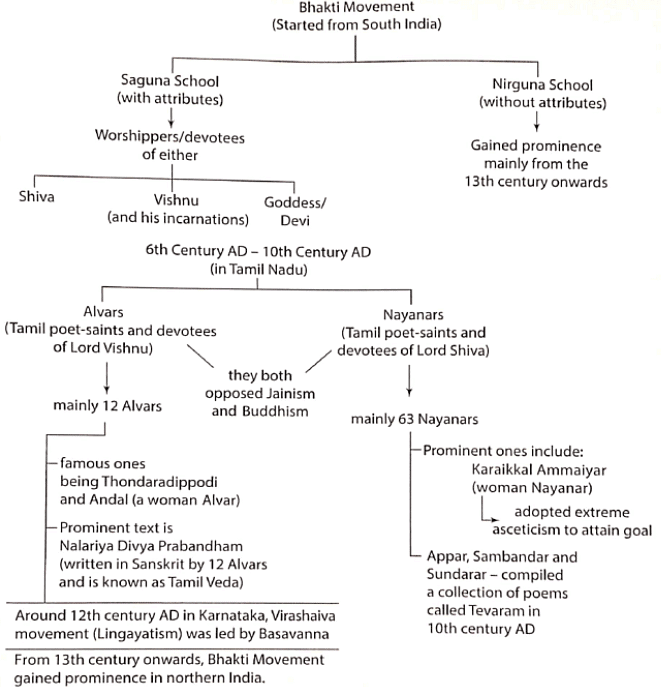The Sufi and Bhakti Movements: A Comprehensive Analysis for UPSC IAS Exam
The Sufi and Bhakti Movements: A Comprehensive Analysis for UPSC IAS Exam
The Sufi and Bhakti movements were two significant religious and cultural movements that emerged in medieval India. These movements played a crucial role in shaping the socio-religious landscape of the Indian subcontinent. They emphasized personal devotion to God, transcending the rigidities of orthodox religious practices and promoting social harmony. This comprehensive analysis covers the origins, key figures, teachings, impact, and legacy of the Sufi and Bhakti movements, providing a detailed understanding for the UPSC IAS exam.
Origins and Historical Context
Sufi Movement
The Sufi movement, a mystical form of Islam, began in Persia and spread to India around the 11th and 12th centuries. Sufism emphasizes the inward search for God and the union of the individual self with the Divine. The term “Sufi” is derived from the Arabic word “safa,” meaning purity, or “suf,” referring to the woolen garments worn by early Sufis as a symbol of their ascetic lifestyle.Sufism in India gained prominence during the Delhi Sultanate and the Mughal Empire. Sufi saints, known as Pirs or Sheikhs, established various orders (silsilas) that played a significant role in spreading Islamic mysticism across the Indian subcontinent. The Chishti, Suhrawardi, Qadiri, and Naqshbandi orders were among the most influential.
Bhakti Movement
The Bhakti movement originated in South India between the 7th and 10th centuries and later spread to the north by the 12th century. The term “Bhakti” means devotion or love towards a personal God. The movement emerged as a response to the rigid caste system and the dominance of Brahminical rituals in Hinduism. It emphasized personal devotion to God as the path to salvation, accessible to all regardless of caste, creed, or gender.The Bhakti movement was influenced by the teachings of the Alvars (Vaishnavite saints) and Nayanars (Shaivite saints) in Tamil Nadu. It later spread to other regions, with prominent saints like Kabir, Ravidas, Guru Nanak, Mirabai, Tulsidas, and Chaitanya Mahaprabhu contributing to its growth.
Key Figures and Teachings
Sufi Saints
- Khwaja Moinuddin Chishti: The founder of the Chishti order in India, Moinuddin Chishti settled in Ajmer and became one of the most revered Sufi saints. He emphasized love, tolerance, and openness to all, regardless of religion or social status.
- Nizamuddin Auliya: A prominent Chishti saint, Nizamuddin Auliya was known for his teachings on love and compassion. He attracted followers from all walks of life and promoted the idea of universal brotherhood.
- Baba Farid: Also known as Fariduddin Ganjshakar, he was a leading figure in the Chishti order. His poetry and teachings emphasized the importance of humility, devotion, and service to humanity.
- Sheikh Bahauddin Zakariya: The founder of the Suhrawardi order in India, he established a center in Multan and played a significant role in spreading Sufi teachings in the region.
- Khwaja Bahauddin Naqshband: The founder of the Naqshbandi order, he emphasized strict adherence to Islamic law (Sharia) and the importance of inner spiritual practices.
Bhakti Saints
- Kabir: A weaver by profession, Kabir’s poetry and teachings transcended religious boundaries. He criticized both Hindu and Muslim orthodoxy and emphasized devotion to a formless God.
- Ravidas: A contemporary of Kabir, Ravidas was a leatherworker who preached the equality of all human beings and devotion to a personal God.
- Guru Nanak: The founder of Sikhism, Guru Nanak’s teachings emphasized the oneness of God, the rejection of caste distinctions, and the importance of honest living and selfless service.
- Mirabai: A Rajput princess and devotee of Krishna, Mirabai’s devotional songs expressed her deep love for Krishna and her disregard for social conventions.
- Tulsidas: A poet-saint known for his epic poem “Ramcharitmanas,” Tulsidas’s works focused on the life and teachings of Lord Rama and emphasized devotion as the path to salvation.
- Chaitanya Mahaprabhu: A proponent of Gaudiya Vaishnavism, Chaitanya Mahaprabhu’s teachings centered on the ecstatic devotion to Krishna through congregational singing and dancing (sankirtan).
Impact on Indian Society and Culture
Promotion of Religious Tolerance
Both the Sufi and Bhakti movements played a crucial role in promoting religious tolerance and harmony in medieval India. Sufi saints like Moinuddin Chishti and Nizamuddin Auliya welcomed followers of all faiths to their dargahs (shrines), fostering an inclusive environment. Similarly, Bhakti saints like Kabir and Guru Nanak preached the unity of God and the futility of religious dogma, encouraging people to look beyond religious differences.
Eradication of Caste Discrimination
The Bhakti movement, in particular, challenged the rigid caste system and promoted social equality. Saints like Ramanuja advocated for the inclusion of lower castes in temple worship, while the Lingayat movement, led by Basava, rejected caste distinctions altogether. Sufi orders also disregarded social hierarchies, with the Chishti order welcoming people from all backgrounds, leading to greater social integration.
Cultural Synthesis
The Sufi and Bhakti movements contributed significantly to the cultural synthesis in India. Sufi music and poetry, such as qawwali, blended Indian and Persian musical traditions, enriching the cultural landscape. Bhakti saints composed devotional songs in regional languages, which enriched Indian literature and music. The works of Alvars and Nayanars in Tamil Nadu, for example, transcended linguistic and cultural boundaries.
Influence on Art and Architecture
The Sufi and Bhakti movements left a lasting impact on Indian art and architecture. Sufi shrines, like the Dargah Sharif in Ajmer, became artistic hubs, showcasing intricate artwork and calligraphy that reflected a fusion of Persian and Indian artistic traditions. The Bhakti movement inspired the construction of magnificent temple complexes and sculptures, such as the Khajuraho temples, depicting scenes of devotion and love.
Social Reforms
Both movements advocated for social reforms and emphasized compassion and social justice. Bhakti saints like Chaitanya Mahaprabhu and Eknath worked towards uplifting the marginalized sections of society. Sufi orders engaged in philanthropy, establishing khanqahs (hospices) that served as centers for spiritual and social welfare.
Influence on Language and Literature
The Bhakti and Sufi movements played a pivotal role in the development of regional languages and literature. Bhakti poetry flourished in languages like Tamil, Marathi, and Kannada, with notable examples being Sant Eknath’s Marathi compositions and Saint Thyagaraja’s Telugu compositions. Sufi poets like Jalaluddin Rumi and Hafiz left an indelible mark on Indian poetry and philosophy, with their works being translated into various Indian languages.
Legacy and Enduring Influence
The legacy of the Sufi and Bhakti movements continues to shape the cultural and religious landscape of India. Their emphasis on personal devotion, social equality, and religious tolerance has left a lasting impact on Indian society.
Religious and Social Harmony
The teachings of Sufi and Bhakti saints have contributed to the spirit of religious and social harmony in India. Their messages of love, compassion, and unity continue to resonate with people across religious and social divides. The inclusive approach of these movements has helped foster a sense of brotherhood and mutual respect among diverse communities.
Development of Vernacular Literature
The Bhakti and Sufi movements played a crucial role in the development of vernacular literature in India. By composing devotional songs and poetry in regional languages, they made religious and philosophical ideas accessible to the common people. This democratization of knowledge and spirituality contributed to the growth of regional languages and literature.
Influence on Indian Music and Performing Arts
The Sufi and Bhakti movements have had a profound influence on Indian music and performing arts. Sufi music, particularly qawwali, has become an integral part of Indian cultural heritage. Bhakti traditions, such as the kirtans of Chaitanya Mahaprabhu and the abhangas of Sant Tukaram, have enriched Indian devotional music. The emphasis on singing and dancing as forms of devotion has also influenced various classical and folk dance forms in India.
Architectural Heritage
The architectural contributions of the Sufi and Bhakti movements are evident in the numerous shrines, temples, and other religious structures built during this period. These structures not only serve as places of worship but also as cultural landmarks that reflect the artistic and architectural achievements of the time.
Social and Religious Reforms
The social and religious reforms initiated by the Sufi and Bhakti movements have had a lasting impact on Indian society. By challenging the rigidities of caste and religious orthodoxy, these movements paved the way for a more inclusive and egalitarian society. Their emphasis on personal devotion and inner spirituality continues to inspire contemporary religious and social reform movements.
Conclusion
The Sufi and Bhakti movements were transformative forces in medieval India, shaping the religious, cultural, and social landscape of the subcontinent. Their emphasis on personal devotion, social equality, and religious tolerance transcended the boundaries of orthodox religious practices and promoted a spirit of inclusivity and harmony. The enduring legacy of these movements is evident in the rich cultural tapestry of India, which continues to be influenced by their teachings and contributions. Understanding the Sufi and Bhakti movements is essential for comprehending the broader historical and cultural context of medieval India, making them vital topics for the UPSC IAS exam.













